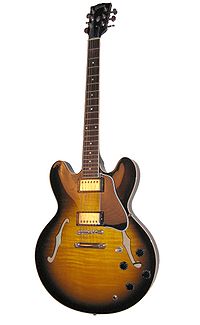Gibson ES-335
 |
|
| Manufacturer | Gibson |
|---|---|
| Period | 1958–present |
| Body type | Semi-hollow |
| Neck joint | Set neck |
| Scale | 24.75 in (629 mm) |
| Body |
Maple (plywood) with maple center block |
| Neck | Mahogany |
| Fretboard |
Rosewood Ebony |
| Bridge | Tune-O-Matic with stopbar |
| Pickup(s) | 2 humbuckers |
| Various, often sunburst-type finishes Wine Red |
|
The Gibson ES-335 is the world's first commercial thinline archtop semi-acoustic electric guitar (also known as "semi-hollowbody" or "thinline"). Released by the Gibson Guitar Corporation as part of its ES (Electric Spanish) series in 1958, it is neither fully hollow nor fully solid; instead, a solid maple wood block runs through the center of its body. The side "wings" formed by the two "cutaways" into its upper bouts are hollow, and the top has two violin-style f-holes over the hollow chambers.
Before 1952 Gibson produced only hollow-body guitars, which are prone to feedback when amplified loudly. That year saw the introduction of their first solid-body, the Gibson Les Paul, a significantly different instrument from Les Paul's early electric guitar experiment, "The Log," which consisted of a center block with detachable chambers on both sides, a neck, hardware, and a pickup attached. By 1958 Gibson was making a few solid-body models which had much lower feedback and better sustain but lacked the darker, warmer tone and unamplified volume of hollow bodies. The ES-335 was an attempt to find a middle ground: a warmer tone than a solid body produced with almost as little feedback. Though semi-hollow-bodies like the ES-335 are essentially a compromise of earlier designs, they are for this reason extremely flexible, as evidenced by the ES-335's popularity in a wide range of music, including blues, jazz, and rock. With a basic price of $267.50, it quickly became a best-seller, and has been in continuous production since 1958.
The first major update came in mid 1962, with the most visible change being the markers on neck: early models had dots (hence "dot neck"), later models had blocks. Notable users were Larry Carlton, Robben Ford, John Scofield, Lee Ritenour, Alvin Lee, Richie Blackmore, Noel Gallagher, and Eric Clapton.
...
Wikipedia
